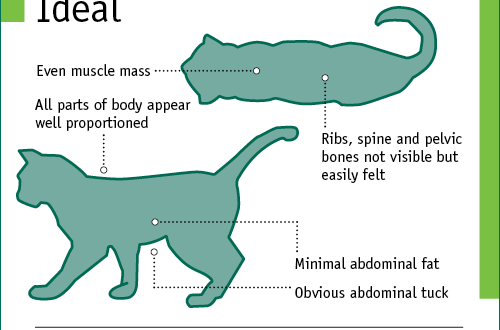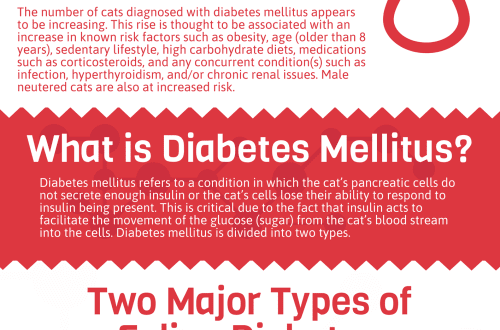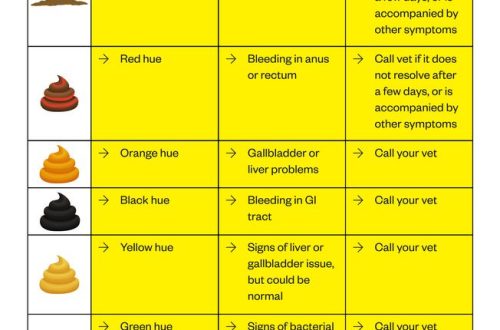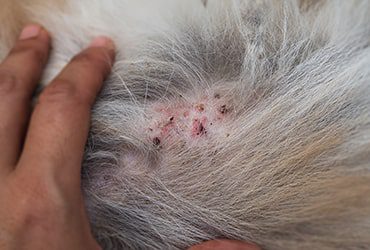
Sores, scabs in cats – causes and treatment of skin diseases

Contents
Skin Diseases in Cats: The Essentials
Skin diseases are very common in both indoor and outdoor cats.
Most often, on the skin of a pet, you can see crusts, wounds, scabs, signs of hair loss.
For diagnosis, such studies as scraping, cytology, culture, skin histology are carried out.
Treatment is most often complex and includes local and systemic drugs for the pet, as well as treatment of the apartment.
The main symptoms and manifestations of skin diseases in cats
Many skin conditions can present with very similar symptoms. Often you can see bald patches, wounds, crusts on the body of the animal. But some diseases have distinctive features, seeing which, you can make a preliminary diagnosis.
Bald lesions on the body of a cat can be found with lichen, demodicosis.
A large number of scales, similar to dandruff, is noted when infected with the Cheyletiella mite.
Wounds with crusts in the head area are noted with itching, which is often due to allergies.
Ulcers on the skin on the body of a cat can be detected with deep infection of the skin, thermal or chemical burns.
Black dots on the chin are a sign of cat acne.
Small crusts on the skin of a cat can indicate miliary dermatitis, so the cat’s body reacts to an infection or allergen.
Pimples with white content can occur with autoimmune diseases or superficial bacterial infections.
Common diseases that cause skin lesions
Lichen
Lichen is a fungus whose spores infect the cat’s coat. Usually the infection comes from another sick animal, and spores can also be brought on clothes and shoes from the street, even if the cat is completely domestic. Lichen in a cat most often looks like rounded bald patches with scales, crusts and scabs. Localization may be different, depending on which part of the body the fungal spores began to multiply. Lichen in cats is often found on the face, especially around the nose, ears and around the eyes. You may notice hair loss and characteristic peeling of the skin. The cat, most likely, will not experience itching and other unpleasant sensations.
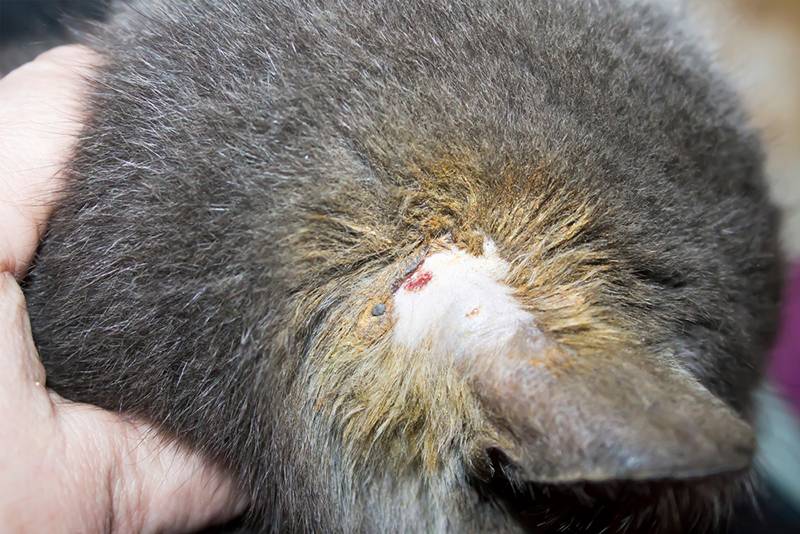
Allergy
There are three types of allergies in cats: flea allergy dermatitis, food allergies, and non-food allergies. Allergy itself is most often a hereditary disease, and signs in a sick animal appear when any of the allergens enters the body. In most cases, they are all visually similar. The first sign of an allergy is itching. With intense itching, the cat will intensively lick itself, especially in the abdomen. Can comb the area around the ears, neck, chin with paws. But cats are very secretive animals and will hide their indisposition from the owner to the last. Often, signs of itching are detected only at the time of administration. Usually, on examination, the doctor finds characteristic wounds from the cat’s claws, as well as, as if trimmed, hair in the abdomen and groin. The cat’s tongue is very rough, with many papillae, and, intensively licking, the cat literally shaves off its own fur.

Also typical of allergies can be lesions called miliary dermatitis. Most often, owners find small crusts on the cat’s neck. Similar sores in a cat can appear on the withers, muzzle and other places. Thus, the cat’s skin reacts to the influence of some external factor, in this case, an allergen. Another characteristic form of allergy manifestation in cats is the eosinophilic granuloma complex. This complex appears in three main forms: eosinophilic granuloma, indolent ulcer, and eosinophilic plaques.
Eosinophilic granuloma in cats most often occurs on the chin or border with the lower lip. It looks like a pink or yellowish swelling, soft to the touch, does not cause obvious discomfort to the cat.
An indolent ulcer usually affects the cat’s upper lip, although it can appear elsewhere on the body. It looks like a lesion on the outer edge of the upper lip on one or both sides of the nose. The lesion initially resembles sores with crusts that grow over time, become clearly defined, have a red or brown surface. Their surface is concave in the center and raised along the edges.
Eosinophilic plaques can be found on the abdomen and inner thighs of a cat. They are oval or elongated in shape. The color is usually pink, the surface is raised. At first, such lesions are very small, but without treatment, they merge and affect large surfaces of the cat’s body.
Scabies Ticks
Three main types of skin mites can be found in cats: demodicosis, notoedrosis, and cheiletielosis. All three types of ticks have their own characteristic clinical signs.
Demodicosis in cats is very rare. Demodex cati is not contagious. Normally, it is present even in healthy animals. The tick begins to multiply and cause clinical manifestations against the background of reduced immunity of the pet. It will look like a hairless patch of skin on any part of the cat’s body. Most often, such a lesion does not cause anxiety in a cat. There may be crusts, scales, pimples on the skin, but they may be completely absent. Another type of demodicosis – Demodex gatoi, on the contrary, is very contagious. Cats with such an infection experience severe itching and comb themselves to the blood.
Notoedrosis is also a contagious disease, transmitted from a sick cat to a healthy one. In the environment, ticks live for a short time and die fairly quickly. Places affected by a tick will look like thickened skin with a lot of crusts and scabs. Scabs on the skin of a cat with notoedrosis can appear throughout the body, but more often – on the neck, head, chin, ears. The cat, most likely, will intensively scratch these places with its paws. Wool in these places also falls out. Heyletielez is transmitted between cats, dogs, rabbits, outwardly similar to the manifestations of dry seborrhea. Owners may notice that the cat’s skin is very flaky. Usually these peelings are very pronounced, flaky scales that remain throughout the apartment where the cat was. Only a small area of the body may be affected, but most of the skin may be affected.
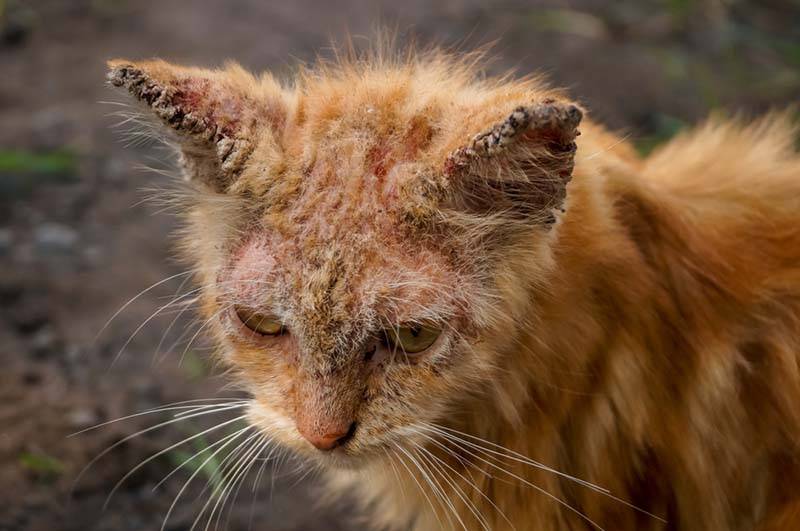
Акне
Acne in cats is not actually a disease. Often it is just a sign of an allergy in a pet. But sometimes it is not possible to establish its cause. Usually, the reason for contacting the clinic is the discovery by the owner of sores on the chin of a cat. At the beginning of the disease on the chin, only black small dots can be noted – comedones. Comedones are pores clogged with dirt, sebum and pieces of epithelium. Without treatment, their number increases. Then large red or white-headed pimples and boils appear on the chin.
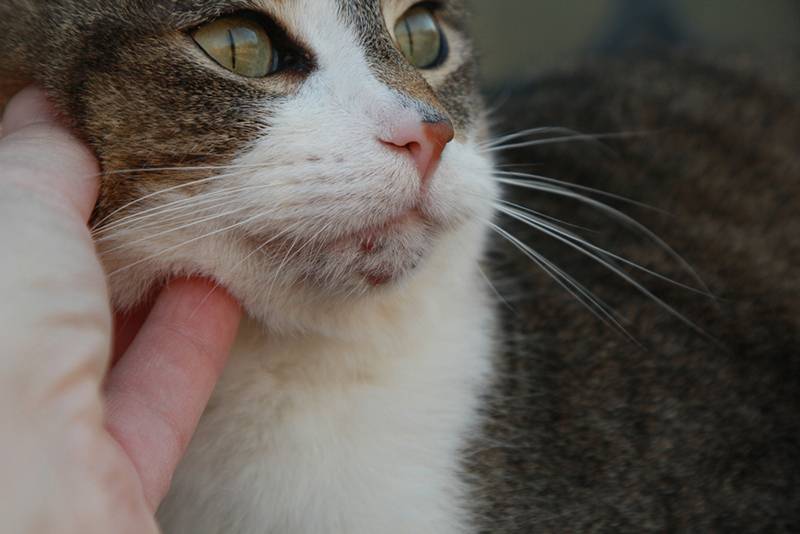
Autoimmune diseases
There are many different autoimmune skin diseases in cats. The exact cause of their occurrence in pets could not be established, but it is assumed that chronic inflammation and a reaction to medications may be the prerequisites. With such a disease, one’s own immune cells begin to attack skin cells, which manifests itself in the form of lesions on the body. Pemphigus foliaceus is one of the most common autoimmune conditions. It is characterized by the presence on the skin of small pustules – pimples with a white head. Finding such small sores under the fur of a cat is quite rare. Most often, lesions become noticeable at later stages. You can note the appearance of crusts, scales, bald patches. A typical lesion is in the auricles and nose, and often the only symptom is thickening and crusting on the paw pads of the cat. Crusts around the nails are also noted in many cases.
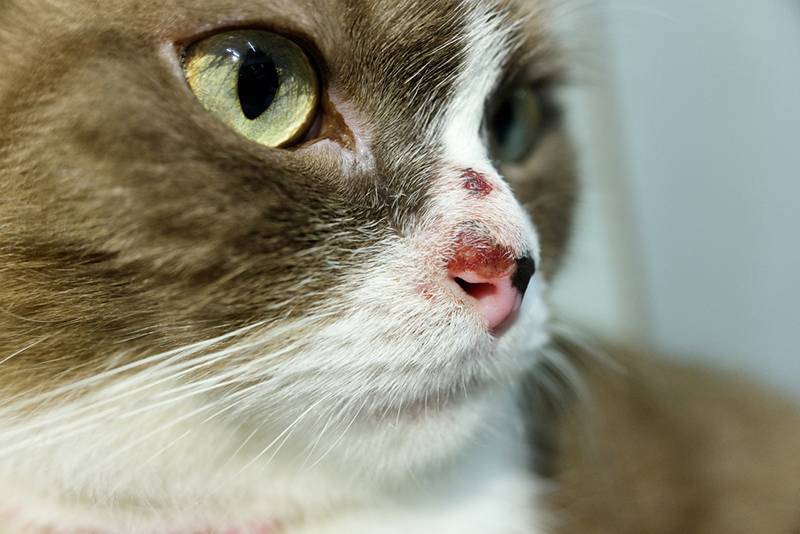
Psychogenic itching
Oddly enough, but in the presence of stress factors, cats can also lick themselves intensively, comb or nibble. Often with this condition, the cat can be noted the presence of a wound on the tail. Her pet inflicts itself with teeth and claws on its own. Stressful factors for cats can be noisy work in the house or with neighbors, rearranging furniture, a long absence of owners, and even changing the filler for the tray or food.

Diagnostics
A preliminary diagnosis can only be made based on the result of the examination, since the diseases have the characteristic clinical signs described above. Additional studies are required to confirm the diagnosis. To exclude the presence of a bacterial or fungal infection, a cytological examination of smears from the skin is performed. Also, thanks to him, you can see the cells that appear in autoimmune diseases. Autoimmune disease is confirmed by skin histology. Skin scrapings can in most cases detect skin mites, but the Demodex gatoi mite is very rare in scrapings, and it is not easy to diagnose this disease. For the diagnosis of lichen, several methods can be used at once. First, the animal is examined under a fluorescent lamp – this method allows you to identify lichen in 50% of cases, since not all types of this infection will glow under the lamp. Then trichoscopy can be performed, thanks to which you can see the hairs destroyed by fungal spores. A more accurate diagnosis is the sowing of hairs in special growth media. Fungi in such media can grow for a long time, up to 3–4 weeks, but the accuracy of this diagnosis is at least 95%.
Most often, identifying an allergen is not an easy task; there are no special tests for this. First, with the help of scrapings, crops, and other things, it is necessary to exclude all alleged differential diagnoses, which will be suggested by the doctor. If allergy remains the most likely diagnosis, the stage of excluding possible allergens will begin. First of all, fleas are excluded, the animal and the premises where it lives are processed. A special elimination diet may then be prescribed to rule out food allergies. If the allergen has not been identified, the diagnosis is “non-food allergy”, or “atopy”.
Treatment of skin diseases in cats
If a bacterial or fungal flora is detected on the affected areas of the body, local and systemic drugs, various antibiotics and antifungal agents are prescribed. If the cat is good at washing, bathing with antibacterial shampoos is convenient. Skin mites are treated with antiparasitic drugs. Recently, modern preparations in the form of drops at the withers have been used for this, they are highly effective. Autoimmune diseases are treated with immune-suppressing drugs called immunosuppressants. Such drugs can be prescribed both as a course and on an ongoing basis. To treat allergies, it is necessary to identify the allergen and exclude it from the life of the animal. But this is not always possible to do. Otherwise, drugs against itching and inflammation are used. If the pet’s allergy is seasonal, then the tablets should be taken only during the period of exacerbation. If the allergy is constant year-round, then the drugs will have to be used for life, trying to choose the minimum effective dosage. For the treatment of psychogenic itching, sedatives and antidepressants are used.
Prevention
The main methods of preventing skin diseases in cats include regular antiparasitic treatments. The use of drops at the withers, even for domestic cats, avoids many unpleasant situations associated with flea and tick infestation. Contacts of a domestic cat with stray animals should be limited. It is necessary to organize the environment for the pet in such a way that he does not need anything and does not experience chronic stress. Stress can lead not only to psychogenic itching, but also to a decrease in the overall immunity of the body.
Skin diseases in kittens
Skin diseases are often found not only in adult pets, but also in kittens. They are more susceptible to infection by lichen and scabies mites. Flea allergy dermatitis is also common in them. Food allergies, on the contrary, are practically not registered in kittens, since at their age the body simply does not have time to form a reaction to a food allergen. Diagnosis and treatment in kittens will not be fundamentally different from those in adult animals.
Can a person get infected from a cat?
Most skin diseases in cats are not transmitted to humans and are contagious only between members of the feline family. Lichen is potentially contagious to humans, and children, the elderly, and people with weakened immune systems are considered especially vulnerable. Adults most often do not become infected from cats. If you find signs of depriving yourself, you should immediately consult a dermatologist. Notoedrosis can cause pseudoscabies in a person, but, in fact, the disease does not require treatment.
Answers to frequently asked questions





